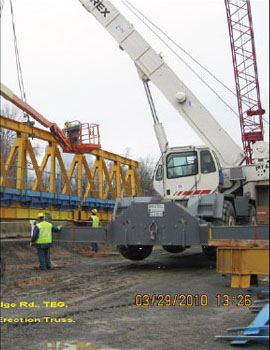Build America Bonds (BABs) were authorized by the American Recovery and Reinvestment Act (ARR A) enacted in February 2009. BABs are taxable bonds that are eligible for an interest rate subsidy paid directly from the U.S. Treasury. States and local governments can issue BABs through December 2010. Surface transportation projects are among other public infrastructure projects (e.g., public buildings, courthouses, schools, water and sewer projects, etc.) that are eligible for BAB financing.
BABs were created to supplement State and local government's capacity to access conventional corporate debt markets for public infrastructure, instead of issuing traditional tax-exempt debt. The BAB program is designed to provide a Federal subsidy for a larger portion of the borrowing costs of State and local governments than traditional tax-exempt bonds in order to stimulate the economy, create jobs, and encourage investments in capital projects in 2009 and 2010.
The BABs subsidy is equal to 35 percent of the interest payment, which results in lower net borrowing costs (see sidebar). The U.S. Treasury has published guidance on use of the BABs program and procedures for applying for refundable credits.

BABs may result in net lower interest costs than comparable municipal tax-exempt debt, and there is no cap on the amount of BABs that can be issued through the end of 2010.
For most issuers, BABs offer a considerable advantage over tax-exempt municipal bond issuance given the current subsidy rate of 35 percent versus prevailing interest rates. BABs also have the advantage of broadening the market for municipal issuers by bringing in new investors who do not benefit from the tax-exemption feature available with typical tax-exempt municipal bond investments.

Tax Credit BABs can be used for the same purposes as tax-exempt borrowing (i.e., new construction, refunding bonds, and working capital). Direct BABs proceeds, however, are strictly limited to new construction. As of December 2010, all BABs debt issued was direct payment, and about 26 percent of the proceeds ($48 billion for surface transportation) had been identified for transportation uses.
BABs have been a considerable success in stimulating the bond markets and enhancing investment in infrastructure. As such, bond market representatives and the Obama Administration have called for direct payment BABs to be made permanent. The Obama Administration, in its 2011 Budget proposals, called for BABs to be made permanent, but at a lower interest rate subsidy - 28 percent instead of 35 percent. New Congressional Budget Office estimates project the BAB subsidies at $3 billion per year versus previous estimates of about $1 billion a year.
There are various types of subsidy arrangements under BABs:
Direct-payment (or qualified) BAB, the most common, in which the issuer (i.e., the State or local government) receives a payment of 35 percent of the interest cost from the U.S. Treasury.
Within this subsidy arrangement, the Recovery Zone BAB has a higher subsidy payment (45 percent of the interest cost); however, these are capped at $10 billion nationwide and can only be used in economically distressed areas.
Tax-Credit BABs, in which the bondholder receives a tax credit equal to 35 percent of the coupon interest.
Direct-Payment BABs versus Tax-Credit BABs
Assuming a $1,000 bond with an interest rate of 10%:
Direct Payment BAB - The issuer would pay 100 percent of the taxable rate interest cost to the investor ($100) and apply for a refundable tax credit itself from the U.S. Treasury in an amount equal to 35 percent of the gross interest paid by the issuer ($35). For the issuer, the effective interest rate is 6.5 percent.
Tax-Credit BAB - The issuer would pay $74.07 in interest and the investor would receive a supplemental credit equal to 35 percent of the interest the issuer paid or $25.93, to provide the total desired annual return of $100. In this manner, the effective interest rate for the issuer is reduced by 26 percent. The investor can apply the tax credits against regular income tax liability and alternative minimum tax, and unused tax credits may be carried forward to the next year.
The FHWA Center for Innovative Finance Support is a one-stop clearinghouse for expertise, guidance, research, decision tools, and publications on highway program delivery innovations. Our website, workshops, and myriad resources support transportation professionals in the use of innovative approaches for delivery of highway projects.
The FHWA Center for Innovative Finance Support's P3 program focuses on resources and capacity building for consideration and use of design-build-finance-operate-maintain (DBFOM) concessions funded through tolls or availability payments.
The FHWA Center for Innovative Finance Support's Alternative Project Delivery program provides information on contractual arrangements that allow for greater private participation in infrastructure development by transferring risk and responsibility from public project sponsors to private sector engineers, contractors and investors.
The FHWA Center for Innovative Finance Support's Project Finance program focuses on alternative financing, including State Infrastructure Banks (SIBs), Grant Anticipation Revenue Vehicles (GARVEEs), and Private Activity Bonds (PABs).
The FHWA Center for Innovative Finance Support's Federal Tolling and Pricing program focuses on the use of tolling and other road user charges as a revenue source to fund highway improvements, and the use of variably-priced tolls as a tool to manage congestion.
The FHWA Center for Innovative Finance Support's Value Capture program explores strategies for tapping into the added value that transportation improvements bring to nearby properties as a means to provide new funding for surface transportation improvements.
Thay Bishop, CPA, CTP/CCM
Senior Program Advisor
Center for Innovative Finance Support
61 Forsyth Street, Suite 17T26
Atlanta, GA 30303
(404) 562-3695
Thay.Bishop@dot.gov